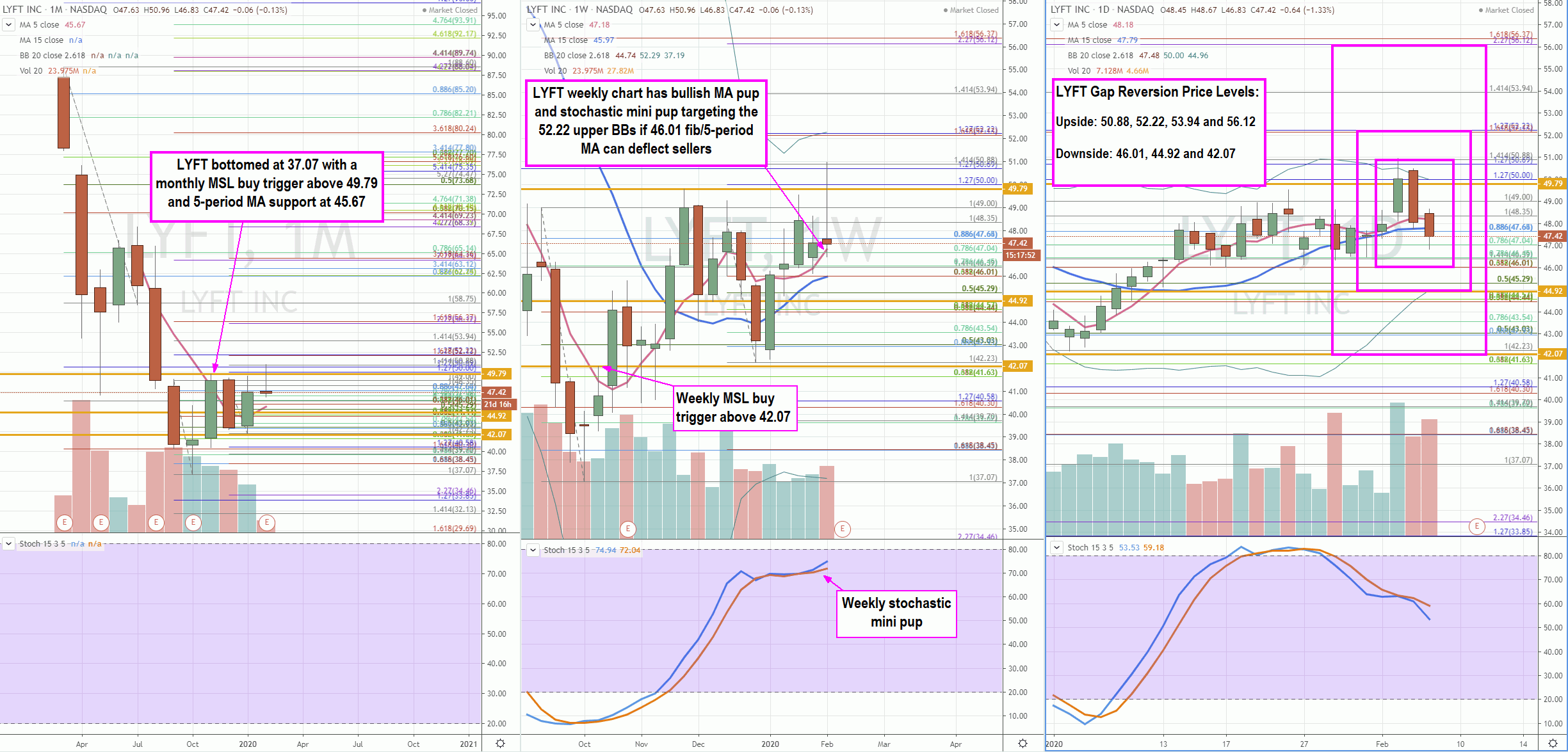
Shares of multi-modal transportation platform operator Lyft, Inc. (NASDAQ: LYFT) have made an impressive recovery since hitting all-time lows of 37.07 in October 2019. As the number two player in the rideshare duopoly behind unicorn Uber Technologies (NASDAQ: UBER). Lyft has shaped its narrative as the “pure play” U.S. multi-modal transportation platform adopting a “path to profitability” servicing rideshare as a transportation network company (TNC) and rapidly expanding its footprint in the electric bike and scooter rental market. While Uber attempts to platform and broaden the scope of business lines to include meal delivery, financial services, gig jobs, freight trucking, autonomous cars, air taxis and helicopter rides on a global scale, Lyft is simply focused on growing its multi-modal platform business in the United States.
Earnings Catalyst
Lyft reports Q4 2019 earnings on Feb. 11, 2020 after the close followed by the 4:30pm EST conference call. Consensus estimates are for a loss of (0.53) per-diluted-share on revenues of $984.25 million. As a pure domestic rideshare operator, investors will want more visibility on the impact of the California Assembly Bill 5 (AB5) law. While the gig-worker law is currently ringfenced to California, investors fear it may spread to other states. California is also a top-three market for Lyft. This has prompted Lyft to join forces with peers Uber, DoorDash and PostMates in a $90 million initiative to challenge AB5. Unlike Uber, Lyft won’t reveal quarterly gross booking figures (total collected fares and total rides), but rather focus on Revenue Per Active User (RPAR) metrics and contribution margins. Nonetheless, analysts have adopted these metrics as sentiment turned bullish on Uber Q4 2019 earnings reaction on Feb. 6, 2020. Despite growing losses to $1.1 billion up for $847 million year-over-year (YOY), they were less than the $1.5 billion analysts expected. Sentiment determines which reality to adopt. Price action reveals the sentiment. Uber earnings galvanized the positive sentiment heading into Lyft earnings as the S&P 500 ETF (NYSEARCA: SPY) continues to challenge all-time highs.

Technical Analysis
Utilizing the rifle charts, Lyft peaked off a high of 88.60 on its IPO to hit a low of 37.07 as it bounced just shy of the monthly market structure low (MSL) at 49.79, which is a key breakout price trigger. The monthly 5-period moving average (MA) support sit at 45.67. The weekly chart has a pup breakout and stochastic mini pup targeting the upper Bollinger Bands at 52.22 fib as long shares can hold above the 5-period MA at 47.18 and 15-period MA at 46.01 Fibonacci (fib) level. The daily charts have a make-or-break situation with a moving average pup breakout attempt versus the stochastic mini inverse pup. The pup breakout targets the 50 upper BB/fib. The mini inverse pup targets the lower BBs at 44.92. Both daily upper and lower BBs are worthy reversion price levels.
Sympathy Stocks:
The obvious sympathy stock for Lyft is Uber. In fact, either stock is interchangeable daily as the leader and laggard depending on which is making new highs or lows intraday. The trading blueprint for Uber can be utilized on Lyft earnings reaction as a laggard mover. The question will be whether the positive sentiment will be priced into Lyft shares triggering a sell-the-news reaction or if Lyft can continue to perpetuate the positive sentiment.
Trading Game Plan:
Lyft’s daily BBs are in a contraction phase as both envelopes point inward. Contractions precede price expansion often triggered by an event catalyst (IE: earnings report). If trading the earnings reaction, the highest volatility will occur on the morning session at the opening bell Wednesday morning. Earnings gaps can be scalped using the upside gap reversion price levels (short-sell) at 50.88 fib, 52.22 weekly upper BBs/super fib, 53.94 fib and 56.12 fib. Downside gap price levels (buy long) are 46.01 weekly 15pd MA/super fib, 44.92 monthly MSL trigger and 42.07 weekly MSL trigger. Reversion levels can be enveloped for the. Scalp gains can range from 15-cents to 35-cents right off the open and then shrink as the day wears on. Reversion trading is meant for quick scalps playing the second reaction on the gap patterns. Swing traders and investors can focus on the weekly chart targeting the upper BBs on the double-barrel pups while monitoring the daily BBs contraction that will eventually commence the expansion phase which could push shares to the 56.32 fib on a breakout or 42.07 on a breakdown. The trading blueprint price levels can be a reference to project price inflection points throughout the year as the fibs are static.
Before you make your next trade, you'll want to hear this.
MarketBeat keeps track of Wall Street's top-rated and best performing research analysts and the stocks they recommend to their clients on a daily basis.
Our team has identified the five stocks that top analysts are quietly whispering to their clients to buy now before the broader market catches on... and none of the big name stocks were on the list.
They believe these five stocks are the five best companies for investors to buy now...
See The Five Stocks Here
Enter your email address and we'll send you MarketBeat's list of seven stocks and why their long-term outlooks are very promising.
Get This Free Report
Like this article? Share it with a colleague.
Link copied to clipboard.